
Livia Marin, “Nomad Patterns,” 2012. Ceramic, resin, plaster, transfer print. Thirty-two pieces in series. Photo courtesy of artist.
HCCC Curatorial Fellow Sarah Darro recently asked Livia Marin a few questions about the processes and inspiration behind her work. Livia is featured in HCCC’s Case Study Space and is presented in conjunction with the recent exhibition, Treachery of Material: The Surrealist Impulse in Craft.
Sarah Darro: Ceramic crockery seemingly melts into puddles, its patterns casting adrift, in your work. Existing in a solid state of eternal melting, your work captures impossibilities that seem conceived of in a dream state. The illusion of denaturing a material is a primary visual strategy of Surrealism and is famously depicted in Salvador Dalí’s seminal painting, The Persistence of Memory, in which clocks melt. The tension between the materiality of ceramic and the notion of melting makes the illusion even stronger, as clay only becomes more solid and vitrified under extreme heat. How did you conceive of the melting ceramic form, and does it have a conceptual link to Surrealism for you?
Livia Marin: More than the object as such or in isolation, and more than the sole subjectivity of a user, owner, or custodian of a given object, my work looks at the relationship between subject and object. With this in mind, a work can sometimes start from a curiosity in exploring a given material, a specific object, a process of making, or from an idea or feeling of something. The latter was the case for the ceramic pieces that you refer to: the idea of “broken things.” That is, how we relate with things that break and hence relate to aspects of loss and care are what gave rise to this series of ceramic objects. After a period of experimentation and research, I arrived at crockery: objects that are ever present in our everyday life, however liminal they may be. They can be both contemporary and traditional and, just as importantly, their very material nature is enduring yet fragile.
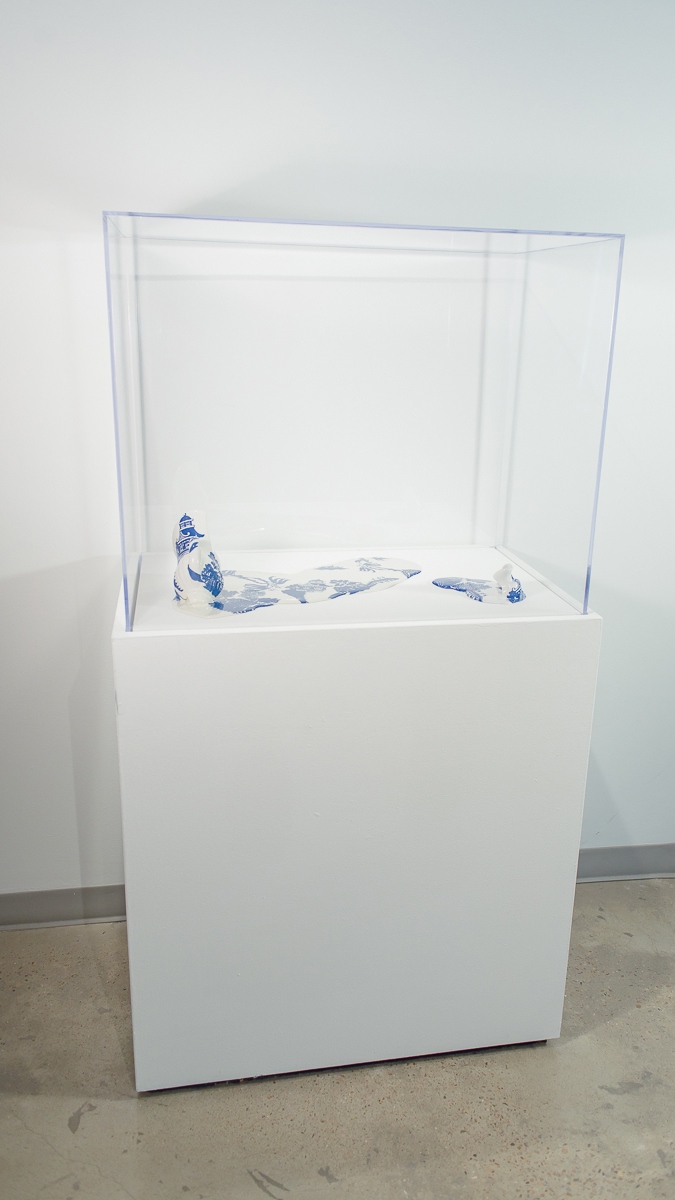
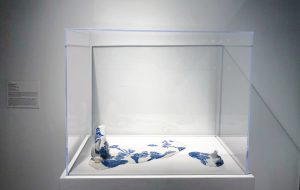
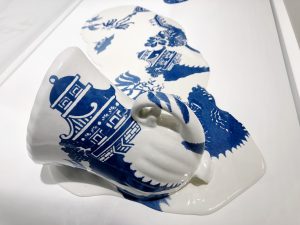
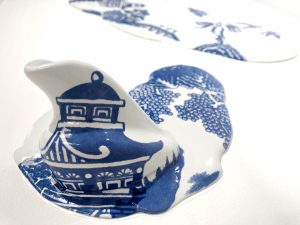
Installation views of “Case Study: Livia Marin” at Houston Center for Contemporary Craft. Left: Livia Marin, “Nomad Patterns (ii),” 2012. Ceramic, resin, transfer print, glaze. Right: Livia Marin, “Broken Things (xvi),” 2012. Ceramic, resin, transfer print, glaze. Photos by Scott Cartwright and Sarah Darro.
I wanted to make an object that could be perceived ambiguously as something that is about to collapse or has just been restored, as if trying to capture precisely the moment of a breakage, of loss, but also of becoming something else, something other. I thought of this as producing a form of strangeness and indefiniteness. In the beginning, I did not think intentionally or consciously of these objects as informed by the impossibility presented by Surrealism, although I did come to see that relationship to them when I first began making them.
As an art student, I was very interested in the work of René Magritte. I felt very compelled by some of his works that present us with a very formal picture of the world that, although seemingly impossible, reaches us as if possible, yet defying cognition through perception and the ability of language to name what we see. There is something trapped in his paintings that I could not stop looking at or searching for. That sense of wonder, of rapture, of contemplation, if I may say so, within the aesthetic tradition, is indeed a force that has inspired me and informed my practice.
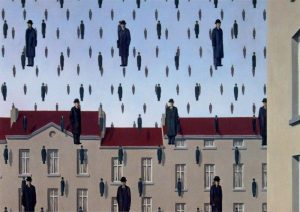
René Magritte, “Golconda,”1953. Oil on canvas. The Menil Collection, Houston.
In relation to language, it is interesting that I never imagined or named these works as “melting.” I thought of them more as a sort of puzzle or contradiction around the notion of spillage: that what is intended to retain becomes itself an act (in suspension) of spillage. There is indeed a further sense of contradiction in that the objects look as if they are melted, when the case is precisely, as you say, that it is heat that gives ceramic its strength, its persistence in time.
SD: Much of your work explores our relationships with objects in an era of late capitalism, one that is dominated by mass-production, standardization, and global circulation. It is particularly poignant that, in Nomad Patterns, you use blue and white ceramic, which is one of the most recognized types of ceramic production in the world, with traditions in Asia, the Islamic world, Europe, and the Americas. How does your work fit into this history of globalization, and how did you come to incorporate ceramics and transferware into your artistic practice?
LM: This is an absolutely central issue, both in this series of works and in my work more generally. Issues like how global trade and the forces of the market determine the presence and absence of the objects that surround us, and how that gives shape to our material surroundings, have been very important in informing my practice. Within the world of the mass-produced and global distribution of objects, the transition between the handmade and mechanical reproduction has been of most interest to me. Within this world, the creation of genuinely unique objects and also the genuine copying of them have become so central in the manufacture of objects and material culture in general. At this stage of consumerism, many mass-produced items attempt to benefit both from economies of scale, while also attempting to brand themselves as “exclusive,” or “signature edition,” and so on. I think an aspect of my work is to offer a critical response to this.
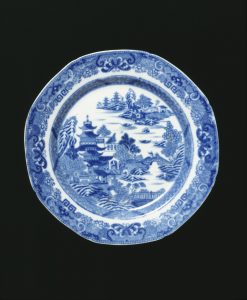
Miles Mason, “The Two Temples,” ca. 1805. Earthenware, transfer printed in underglaze blue. The Victoria and Albert Museum, London.
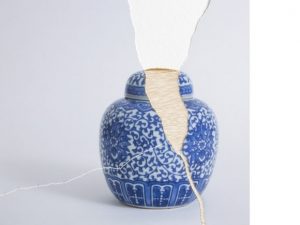
Livia Marin, “Broken Things (mixed media),” 2012. C-Type print, golden thread, paper, wooden frame.
The blue and white ceramic tradition is a great example of the exchanges, mixtures, overlaps—how the other, the unknown, is conceived and presented—that commerce has produced. In this, I have worked particularly with the Willow Pattern, which connotes so many interesting layers of meaning and appropriation. The pattern, conceived by an English man “as if” it were Chinese, is situated at the outset of the second Chinoiserie period (ca. 1780); also, marking the transition from the hand painted to the use of transfer prints and coinciding more generally with the beginning of the Industrial Revolution, it was one of the first motifs to be reproduced using engraving methods that could mechanically reproduce the same motif indefinitely. Today, the Willow Pattern has become a design that has fallen into hackneyed convention through overuse. Equally, however, it carries the ghost of a prestige still accorded to blue and white porcelain, together with a nostalgic glance towards the innocence of an English tearoom and a bucolic past.
SD: This series of work has been widely shared, disseminated, and discussed on the Internet. Knowing that the Internet has, in many ways, propelled globalized networks, I find the viral reception of your work online to be an interesting parallel to your own investigations of globalization. Could you comment on this parallel between the virtual dissemination of your work and the global trajectory of blue and white ceramics? Why do you think this work is resonating with people across the world?
LM: How fascinating: this is the first time I have been asked this question. I have wondered about it myself and, to be honest, I do not have a straightforward answer. I do share with you the sense that what is interesting is the fact of being so interested in the mass-produced and the multiplication of objects, and that this specific work has somehow done something along those lines, parallel to this, in virtual reality: a sort of autonomous mass-production. I guess that the “virtual dissemination” that you mention has to do with two things: with the perception of an image (in this case, the image of the work) and the language of virtual communication and the various social media that governs contemporary life.

Livia Marin, “Nomad Patterns,” 2012. Ceramic, resin, plaster, transfer print. Thirty-two pieces in series. Photo courtesy of artist.
Perhaps the object connotes that contradiction that you mention, between a possible and an impossible world, and does it very efficiently and quickly, which is the rule of the virtual world: in the world of browsing, there is no time for puzzling, for a second look. An image has to provoke in a half second; otherwise it doesn’t register. Whilst this speaks for how people choose to communicate to others today, I would also say that even though the work is simple, it has depth. While it contains a certain tragedy, it has humor at the same time, and, since it employs an everyday object, it resonates with the many gazes of different backgrounds, genders, and ages. Much more could be said, I’m sure, about the transmission of two-dimensional images. It is, perhaps, ironic that my works have found this exposure when they are so grounded in concrete materiality.
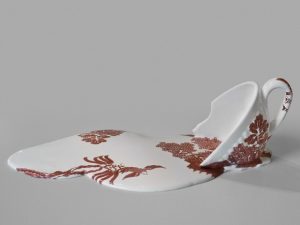
Livia Marin, “Nomad Patterns,” 2012. Ceramic, resin, plaster, transfer print. Thirty-two pieces in series. Photo courtesy of artist.
About Livia Marin
Livia Marin is a London-based Chilean artist. Her work is informed by the social and political context of Chile, specifically the country’s transition from a dictatorship to neo-liberalism. She holds a PhD in art from Goldsmiths College, University of London; an MA in visual arts from Universidad de Chile; and a BA in fine arts from Universidad ARCIS. Marin has exhibited widely both in her native Chile and internationally.

